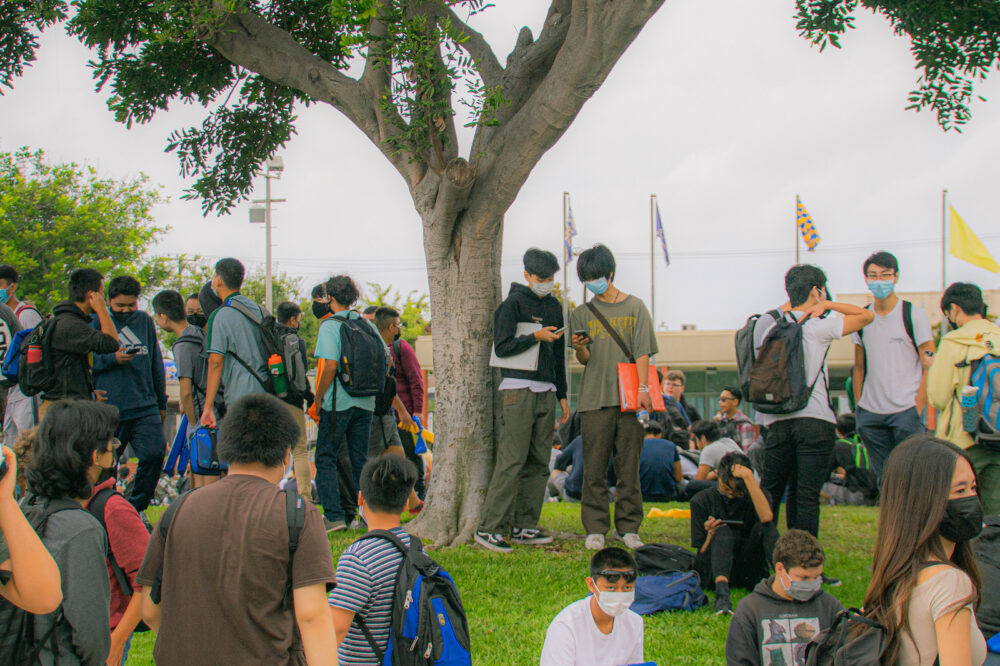
By Cate Meister
Fountain Valley High School (FVHS) Principal Paul Lopez confirmed a rise in COVID-19 cases since students resumed in-person, on-campus learning on Monday, Jan. 3. The rise in cases was also accompanied by a rise in absences amongst students.
According to attendance clerk Loraine Leatherwood, 448 students were absent on Jan. 4, although not all absences were caused by COVID-19 related factors. Leatherwood estimated that about 85 to 100 students are absent on an average school day and echoed Lopez’ statement on increasing absences throughout the week.
The week began with approximately 15 student absences due to positive COVID-19 tests, according to Assistant Principal of Guidance Nancy Peterson. By Jan. 5, that number had doubled to 30. Over twice as many cases were reported the next day, and cases reached their peak on Friday with 130 student cases and 13 staff cases.
Positive COVID-19 tests resulting in absences at Fountain Valley account for 3.82% of the campus’ total population, the highest rate with Huntington Beach Union High School District (HBUHSD). Peterson emphasized that not all COVID-19 cases were present on campus.
While FVHS had the highest total number of COVID-19 absences within the district, the school also has the largest population in the district, with 3,268 students currently enrolled. Still, staff absences due to COVID-19 were comparatively lower; both Edison High School and Westminster High School had more staff members absent on Jan. 7.
However, substitute teacher shortages have caused challenges filling teacher absences across the district, including FVHS, and administration covered classes during the beginning of the week at Fountain Valley.
On the day of HBUHSD’s return, Orange County averaged about 3,224 cases per day, classifying it as a COVID-19 “hotspot” based on New York Times criteria. Orange County currently averages 5,517 cases per day.
At-school cases
In spite of the school’s effort to manage the spread of the virus, some students who tested positive or were in close contact with someone with COVID-19 have attended school this week with knowledge of their status.
A senior who asked to remain anonymous attended school for three days before being sent home by administration. The student had tested positive over break and believed that their quarantine was over because of the change in CDC guidelines.
“I wasn’t sure if I still had [COVID-19] or not, but I just thought, ‘Oh [I] quarantined, so I’m not really contagious anymore,’” the student said. “At the time…I thought I was good to go.”
But confusion regarding quarantine guidelines hasn’t been the only reason exposed or COVID-positive students have been attending school.
A second student, who also requested anonymity, was exposed to COVID-19 on Jan. 4 but decided not to test for the virus, citing academic pressure to remain at school.
“With finals coming up (along with future tests and assignments), I realized that if my [COVID-19] test came back positive then I would have to stay home and miss out on important academic responsibilities,” the student said.
The student added she felt that others in similar situations might choose to attend school regardless of their COVID status, causing her to question the effectiveness of safety measures.
“I feel like it’s also irresponsible for the district to continue school in-person when there’s a huge rise of COVID-19 cases and the number of students attending [school] decreasing,” she said.
Campus impact
With hundreds of students absent on a daily basis (many of which stem from exposure to COVID-19 rather than a positive test), student activities have been forced to adapt to post-break conditions.
Athletics, particularly what Lopez dubbed “gym sports,” have been affected by the rise in cases. Both girls and boys basketball have witnessed positive cases of COVID-19, with boys basketball making up the brunt of athletic cancellations.
Clubs have also deviated from their typical operations because of the rise in cases.
“I have decided to cut back on the amount of events in January due to the rising cases due to [the] Omicron [variant],” said Ecology Club co-president junior Giauy Ngo, who typically plans for around two club events per month.
However, some aspects of student life remain unchanged. Assistant Principal of Activities and Athletics Hayato Yuuki said that planning for the winter formal dance scheduled for Jan. 29 is still underway. While a change in health guidelines could impact the dance’s fate, the dance has not been canceled or postponed thus far.
The dance’s current venue, the Dana Point Ocean Institute, has both an indoor and outdoor area for students, which would help accommodate larger numbers of students.
“When we were planning for the winter formal, we were already planning around COVID,” Yuuki said. “It’s going to be highly encouraged and highly recommended that kids wear their masks even when they’re outside.”
District Response
HBUHSD principals met with district officials on Wednesday to address the post-holiday surge attributed largely to the Omicron variant of the virus. The meeting prompted Lopez and other district principals to send an email to families detailing the current policy: masking, personal sanitation, quarantines, contact tracing, and testing.
Lopez also added that FVHS has placed a particular emphasis on medical grade masks if possible.
“The big thing right now is masking is huge for us,” Lopez said. “We probably should be masking outside…If students are hanging out in groups, they need to be masked.”
HBUHSD is also expected to receive rapid COVID-19 testing kits from the state. According to Lopez, FVHS has started to receive small batches, but has not received the vast majority of the tests, which are a part of Gov. Gavin Newsom’s effort to keep Californian schools open.
Lopez similarly prioritized keeping FVHS open in spite of rising cases because of the mental, social and emotional impacts that online learning has on students.
“We don’t want to stop [in-person learning]…just to go back to where we were. I think it’s harmful in other ways,” Lopez said.





